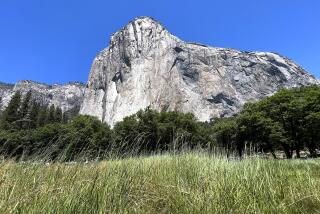Hearing Reopens Dispute Over Yosemite
- Share via
YOSEMITE — Renewing debate over Yosemite Valley’s future, a key congressman and the National Park Service’s top official squared off here Tuesday over proposals to reduce parking and campsites on the crowded but much-coveted valley floor.
During a congressional field hearing in an auditorium beneath the valley’s granite cliffs, Rep. George Radanovich (R-Mariposa) signaled his intent to push for partial reconstruction of riverfront campgrounds destroyed by flooding and voiced continuing opposition to a proposal to reduce parking spaces in the valley.
“I will not allow Yosemite to become an exclusive retreat,” vowed Radanovich, who has opposed a Park Service plan to ease visitor impact on the valley by boosting shuttle service from remote lots outside the park and returning some areas to a more natural state. “There’s a concern about locking people out of the park.”
The congressman’s pitch got a cool reception from National Park Service Director Fran Mainella, who said it would lead to lawsuits that could tie up the Yosemite Valley Plan, a blueprint for the valley’s future approved two years ago after about 20 hearings and 11,000 public comments.
“The National Park Service is never trying to keep visitors away,” Mainella said.
The hearing reopened a fight that has been simmering since the valley plan won approval in the waning days of the Clinton administration.
At the heart of the debate are sharply divergent opinions on how the valley -- seven miles long and a mile wide with a huge swath off limits because of rock falls and flood zones -- should be shaped in the 21st century.
Before the hearing, scores of protesters from outlying communities demonstrated with picket signs and chants. More than a dozen came dressed in prison-striped black-and-white outfits provided by Chuck Cushman, a national property rights activist working with neighboring residents. They are trying to undo parts of the plan, complaining of environmental elitism and a nagging decline in park attendance.
Peggy Mosley, owner of the Groveland Hotel, meanwhile, told the panel that she’s seen a 25% drop in business over the past year. She and other merchants blame reduced business on lower numbers of visitors to the park. Many already believe they’ll have to ride a bus into the park, she said.
Of the proposal to reduce parking, Mosley said: “We’re sort of killing flies with sledgehammers.”
But some environmentalists countered that the time for talk is long over.
Jay Watson of the Wilderness Society said the Yosemite Valley Plan has been endlessly debated, and the ratified final product strikes “an elegant balance” between visitor needs and nature. Restoration efforts along the Merced River, the tributary cutting down the center of the valley, “are the heart and soul of the plan,” he said.
Although a recently completed Park Service study determined that 144 campsites could be reconstructed outside a 150-foot buffer zone running along the river, such an effort almost certainly would involve reopening the valley plan, said Mainella, the park service director. The flood of 1997 devoured 374 campsites; none has been rebuilt.
Mainella said a two-thirds reduction in parking spaces -- from the current 1,650 to 550 -- and an increase in shuttle buses from satellite lots on Yosemite’s edge are not anticipated for at least seven years. By then, she said, the Park Service may find that roadway changes in the valley have stemmed occasional bouts of summertime gridlock now bedeviling the park.
After the hearing, Radanovich said he is confident that the Park Service will abandon its plan for satellite lots and a huge new fleet of buses to ship in visitors. He also said he’s hopeful “a dialogue” can be initiated with environmental groups and parks officials to find a way to rebuild the campgrounds without undoing the plan. If that fails, he said, legislation to force the issue “is a real possibility.”
More to Read
Sign up for Essential California
The most important California stories and recommendations in your inbox every morning.
You may occasionally receive promotional content from the Los Angeles Times.










